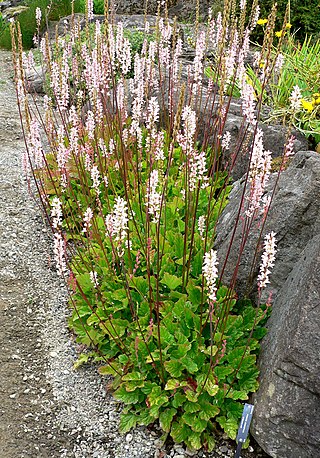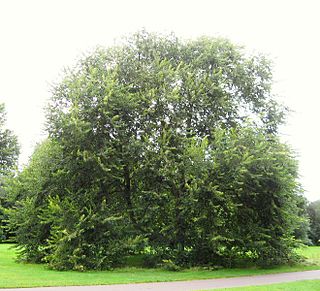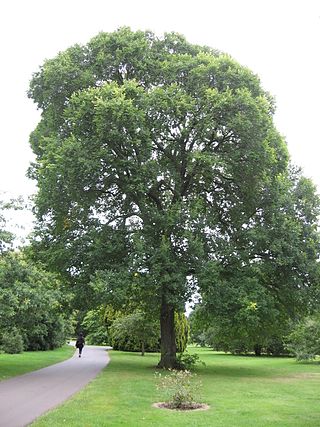
Royal Botanic Gardens, Kew is a non-departmental public body in the United Kingdom sponsored by the Department for Environment, Food and Rural Affairs. An internationally important botanical research and education institution, it employs 1,100 staff. Its board of trustees is chaired by Dame Amelia Fawcett.

The Francoaceae are a small family of flowering plants in the order Geraniales, including the genera Francoa, commonly known as bridal wreaths. The Francoaceae are recognized as a family under various classification schemes. Under the 2009 APG III system the Francoaceae were included within the Melianthaceae. In the 2016 APG IV system the Francoaceae are again recognized as a family, with Melianthaceae included in the circumscription of Francoaceae.

The Zygophyllales are an order of dicotyledonous plants, comprising the following two families:
Cypress is a common name for various coniferous trees or shrubs of northern temperate regions that belong to the family Cupressaceae. The word cypress is derived from Old French cipres, which was imported from Latin cypressus, the latinisation of the Greek κυπάρισσος (kyparissos). Cypress trees are a large classification of conifers, encompassing the trees and shrubs from the cypress family (Cupressaceae) and many others with the word cypress in their common name. Many cypress trees have needle-like, evergreen foliage and acorn-like seed cones.

The Marantaceae are a family, the arrowroot family, of flowering plants consisting of 31 genera and around 530 species, defining it as one of the most species-rich families in its order. Species of this family are found in lowland tropical forests of Africa, Asia, and the Americas. The majority (80%) of the species are found in the American tropics, followed by Asian (11%) and African (9%) tropics. They are commonly called the prayer-plant family and are also known for their unique secondary pollination presentation.

Joseph Marie Henry Alfred Perrier de la Bâthie was a French botanist who specialized in the plants of Madagascar.
Index Fungorum is an international project to index all formal names in the fungus kingdom. As of 2015 the project is based at the Royal Botanic Gardens, Kew, one of three partners along with Landcare Research and the Institute of Microbiology, Chinese Academy of Sciences.
William Botting Hemsley was an English botanist and 1909 Victoria Medal of Honour recipient.

In botany, a peduncle is a stalk supporting an inflorescence or a solitary flower, or, after fecundation, an infructescence or a solitary fruit. The peduncle sometimes has bracts at nodes. The main axis of an inflorescence above the peduncle is the rachis. There are no flowers on the peduncle but there are flowers on the rachis.

Ulmus villosa, the cherry-bark elm or Marn elm, is one of the more distinctive Asiatic elms, and a species capable of remarkable longevity. It is endemic to the valleys of the Kashmir at altitudes of 1,200–2,500 metres but has become increasingly rare owing to its popularity as cattle fodder. Mature trees are now largely restricted to temples and shrines where they are treated as sacred. Some of these trees are believed to be over 800 years old.

Nicholas Edward Brown was an English plant taxonomist and authority on succulents. He was also an authority on several families of plants, including Asclepiadaceae, Aizoaceae, Labiatae and Cape plants.

Dipentodontaceae is a family of flowering plants containing two genera.
- DipentodonDunn - southern China, Assam, Myanmar
- PerrottetiaKunth in F.W.H.von Humboldt - southern China, Southeast Asia, Papuasia, Queensland, Hawaii, Latin America.

In botany, sessility is a characteristic of plant parts that have no stalk. Plant parts can also be described as subsessile, that is, not completely sessile.

Kew Gardens is a botanic garden in southwest London that houses the "largest and most diverse botanical and mycological collections in the world". Founded in 1840, from the exotic garden at Kew Park, its living collections include some of the 27,000 taxa curated by Royal Botanic Gardens, Kew, while the herbarium, one of the largest in the world, has over 8.5 million preserved plant and fungal specimens. The library contains more than 750,000 volumes, and the illustrations collection contains more than 175,000 prints and drawings of plants. It is one of London's top tourist attractions and is a World Heritage Site.

In botany, a whorl or verticil is a whorled arrangement of leaves, sepals, petals, stamens, or carpels that radiate from a single point and surround or wrap around the stem or stalk. A leaf whorl consists of at least three elements; a pair of opposite leaves is not called a whorl.
The Plant List was a list of botanical names of species of plants created by the Royal Botanic Gardens, Kew and the Missouri Botanical Garden and launched in 2010. It was intended to be a comprehensive record of all known names of plant species over time, and was produced in response to Target 1 of the 2002–2010 Global Strategy for Plant Conservation, to produce "An online flora of all known plants". It has not been updated since 2013, and has been superseded by World Flora Online.

The World Checklist of Selected Plant Families was an "international collaborative programme that provides the latest peer reviewed and published opinions on the accepted scientific names and synonyms of selected plant families." Maintained by the Royal Botanic Gardens, Kew, it was available online, allowing searches for the names of families, genera and species, as well as the ability to create checklists.

Ulmus 'Karagatch' is a hybrid cultivar from Turkestan, selected in the early 20th century and considered either a backcrossing of U. × androssowii and U. pumila, or simply a cultivar of × androssowii. It was grown from seeds, introduced from Bairam Ali in Russian Turkestan by Arthur P. Davis in the 1930s, as U. 'Karagatch', under which name it was planted at Kew.
Plants of the World Online (POWO) is an online database published by the Royal Botanic Gardens, Kew. It was launched in March 2017 with the ultimate aim being "to enable users to access information on all the world's known seed-bearing plants by 2020". The initial focus was on tropical African Floras, particularly Flora Zambesiaca, Flora of West Tropical Africa and Flora of Tropical East Africa.

World Flora Online is an Internet-based compendium of the world's plant species.















